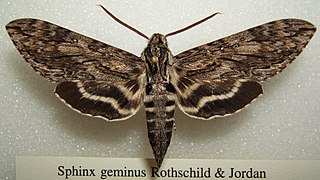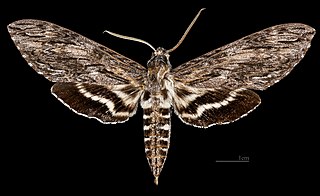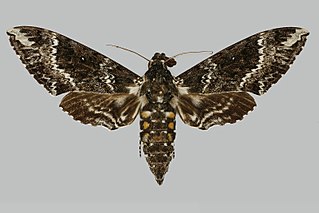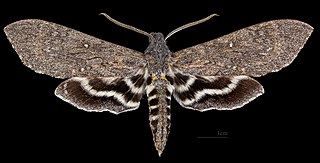
Lintneria eremitus, the hermit sphinx, is a moth of the family Sphingidae. The species was first described by Jacob Hübner in 1823. It is found in the temperate areas of the eastern United States, north into southern Canada over the Great Plains. It prefers gardens and yards, but is common wherever the nectar and larval host plants are found. This moth is easily confused with the Canadian sphinx but these two moths do not typically co-occur.

Lintneria eremitoides, the sage sphinx, is a moth from the family Sphingidae. The species was first described by Herman Strecker in 1874. It is known from North America's sandy prairies in the Great Plains from Kansas south through central Oklahoma to Texas, and possibly west to Colorado and New Mexico, and as a rare stray to western Missouri.

Lintneria geminus, the gemmed sphinx, is a moth of the family Sphingidae. The species was first described by Walter Rothschild and Karl Jordan in 1903. It is found from Mexico to Honduras and Nicaragua with an occasional stray into Texas.

Lintneria istar, the Istar sphinx moth, is a moth of the family Sphingidae. The species was first described by Walter Rothschild and Karl Jordan in 1903. It is found in mountains and pine-oak woodlands from southern Arizona east to southern Texas and south through Mexico to Guatemala.

Lintneria lugens is a moth of the family Sphingidae.

Lintneria merops is a moth of the family Sphingidae.

Lintneria praelongus is a moth of the family Sphingidae.

Lintneria separatus, the separated sphinx, is a moth of the family Sphingidae. The species was first described by Berthold Neumoegen in 1885. It is found from Colorado south through New Mexico and Arizona to Veracruz and Hidalgo in Mexico.

Manduca camposi is a moth of the family Sphingidae. It is known from Ecuador.
Lintneria arthuri is a moth of the family Sphingidae. It is known from Bolivia.
Lintneria balsae is a moth of the family Sphingidae. It is known from Mexico.
Lintneria biolleyi is a moth of the family Sphingidae. It is known from Costa Rica and Guatemala.
Lintneria justiciae is a moth of the family Sphingidae. It is known from south-eastern Brazil, eastern Argentina and Uruguay.

Lintneria maura is a moth of the family Sphingidae.

Lintneria phalerata is a moth of the family Sphingidae. It is known from Argentina and Bolivia.
Lintneria pitzahuac is a moth of the family Sphingidae. It is known to be from Mexico.
Lintneria porioni is a moth of the family Sphingidae. It is known from Peru.

Lintneria pseudostigmatica is a moth of the family Sphingidae. It is known from Mexico.
Lintneria tricolor is a moth of the family Sphingidae. It is known from Dominica.
Lintneria xantus is a moth of the family Sphingidae. It is known from Baja California and north-western Mexico.













